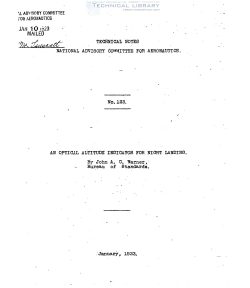naca-tn-123
- Version
- 127 Downloads
- 329.01 KB File Size
- 1 File Count
- November 3, 2016 Create Date
- November 3, 2016 Last Updated
National Advisory Committee for Aeronautics, Technical Notes - An Optical Altitude Indicator for Night Landing

That practical commercial aviation has come to stay
must be admitted by even the most skeptical. The rapid ad-
vance which the past few years have witnessed is unmistak—
ably the forerunner of greater activity in-this comparative—
ly new field of communication and transportation. It is at
once evident, however, that the greatest benefit cannot be
derived from the use of aircraft as commercial carriers‘
unless-their operation can be extended over the full twenty—
four hour.day; for their inactivity during the hours of
darkness robs them to a great extent of their advantage
over the systems of ground transportation.
For this reason the problem of flying at night and
under other conditions of low visibility is now demanding
the attention of many aeronautical experts. We must eQuip
our airways and aircraft with suitable means for surmount-
ing the obstacles offered by these adverse conditions.
This of course involves the installation of markers and
beacons to clearly define the routes and fields, and also
the equipping of aircraft with suitable instruments for
navigation and landing. One of the most-ingenious of the
devices intended for use in night landing, especially emer-
gency landing, is a very simple optical instrument known as
the Jenkins night altitude indicator.'
Referring to Fig. l, we note three projectorsz‘ A, B,
and C, each of which is equipped with an incandescent lamp
properly mounted at the upper extremity to project a beam of
light downward through the tube to the ground or water upon,
which a landing is to be made. Two of these projectors: B
and G, are attached rigidly and parallel to each other to
the side of the aircraft, while the third, A, is made rotat-
able (upon rails D and E) through a certain angle in a plane
parallel to the foreeand—aft axis of the ship. Motion of
A is brought about by the aviator who manipulates a hand-
wheel operating through a pinion mating with rack F.
Projectors B and G are each equipped with an object
screen which provides a characteristic image on the landing"
surface; as shown in Figs. 8 and 3, a rectangular bar is
projected by; B and two blunt arrowheads by G. The ground
image from A is the altitude figure representing the par—
ticular altitude for which the projector is set.
| File | Action |
|---|---|
| naca-tn-123 An Optical Altitude Indicator for Night Landing.pdf | Download |
Comment On This Post